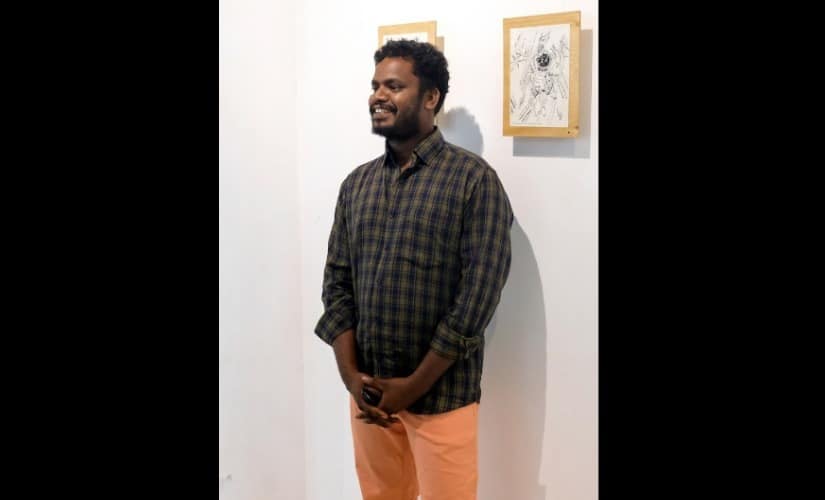A barefoot, sari-clad woman of middling age walks with a bundle atop her head, and one held in the crook of her arm. The road curves beyond and ahead of her, trees cast long shadows on the path, and the woman’s face holds a downcast yet determined expression. The strokes of the drawing, using only black and white, convey a certain indefinable quality: you are transported alongside the woman, walking the path beside her. When I saw it, the drawing was housed in the expansive gallery of the Dr J Jayalalithaa Music and Fine Arts University in Chennai. The woman in the drawing — artist Anthony Guruz’s great-aunt — was on her way from her village in the district of Villupuram, to that of her nephew’s — a distance of 30 km. The nephew was unwell, and the woman — bearing kitchen essentials for a month and the money she earned as an agricultural labourer — was going to his home, to nurse him back to health. Guruz, 32, had heard the story of his father’s remarkable athai (paternal aunt). And when he decided to undertake a walking project of his own, perhaps it was natural that he should learn to appreciate his grand-aunt’s gumption even more. Titled ‘Moothaiyar’ (Ancestor), the drawing is part of an exhibition — Walkway Sketches — of Guruz’s works, and also his MPhil thesis in Visual Communication. As part of his work on the thesis, Guruz decided to embark on a journey by foot — like his grand-aunt decades ago — but over 300 km. Guruz’s route began at Chennai, ending at Nagapattinam, following the East Coast Road. The journey would normally have taken about 15 days, but in Guruz’s case, became longer as he was also “collecting experiences, meeting people and understanding life”. And along the way, he deftly sketched the experiences, animals, personalities he encountered — a true artist’s travelogue. Every drawing was a story. [caption id=“attachment_8144951” align=“alignnone” width=“825”]
 All images courtesy of Anthony Guruz[/caption] [caption id=“attachment_8144961” align=“alignnone” width=“825”]
 The artist[/caption] Guruz has been a professional commercial artist through a 10-year career, but the walk and the drawings that emerged from it were something he did for himself. “They are not cohesive. In fact, every sketch has an entirely different story to tell. But all the stories were about my journey or about leading it. My travels constitute the core of this exhibition. When you see the artworks together, you will see and understand my travels,” Guruz told this correspondent. His drawings, however, are not only a record of the distance he travelled, but also of how the road itself was changing. For instance, Guruz could not help but observe the extent to which elites control the East Coast Road. “There are private beaches and huge, well-decorated gates… as if they are trying to imprison the water and the breeze,” he says, pointing to his drawings of these gated spaces. And the drawings are more political than they appear at a first, casual glance. There are dead butterflies (they hover over the flowerpots meant to beautify the road dividers, but are hit by speeding cars as they flutter back and forth) and renderings of Ambedkar’s statues. The statues cast — literally — a long shadow over Guruz’s travels, and in their shade, he found comfort and security. “Whenever I see a clear blue sky, I am reminded of Ambedkar, it gives me hope. If the sky is clear, it means there won’t be any rains, there is still some light, and I can walk a bit more. That is the security I draw from Ambedkar,” Guruz says.
In attempting to recreate a significant incident from family lore, artist Anthony Guruz walked from Chennai to Nagapattinam along the East Coast Road — a distance of some 300 km — over a month. As he walked and encountered people, places and things, Guruz sketched. A series of black and white drawings now encode a visual story of that journey: poignant observations that Guruz would never have made, had he not walked the road as a pedestrian.
Advertisement
End of Article


)
)
)
)
)
)
)
)
)



